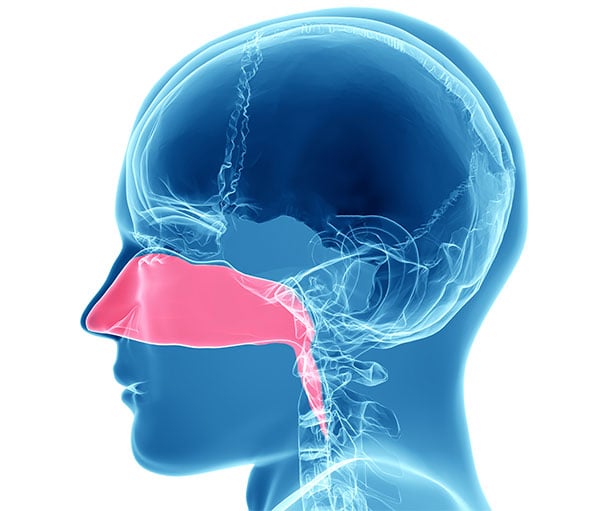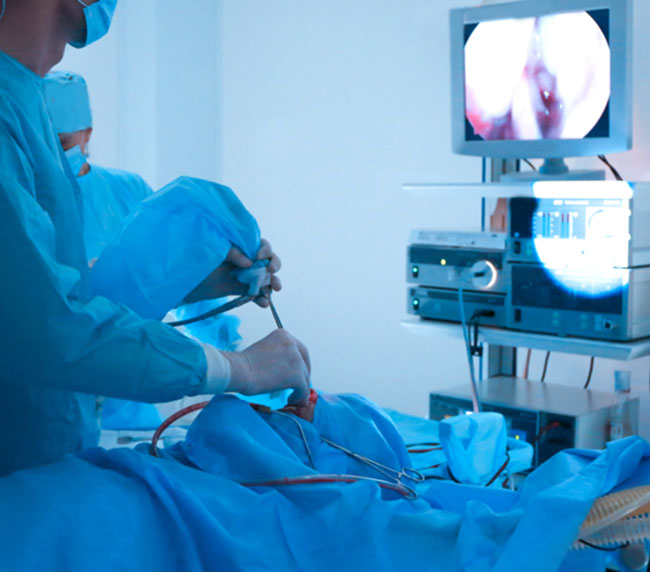It’s a feeling some of us know all too well: congested, stuffy, obstructed breathing that leaves you gulping air through your mouth and struggling to sleep through the night. If your nose is perpetually “stuffed” — but you don’t have a cold or allergies — then you’ve probably looked everywhere for a solution.
For some people, the answer to chronic difficulty breathing actually lies in the anatomy of the nasal cavity. Let’s take a look at how our noses are structured, and how a deviated septum or enlarged turbinates can impact your breathing. From there, we’ll check out septoplasty and turbinate reduction — common ENT procedures that can relieve the discomfort of an obstructed nose.
The Anatomy of Your Nose
Let’s dive a little deeper into the anatomy of your nose, to see how issues like a deviated septum or enlarged turbinates can impact your breathing.
The Nasal Cavity
Although you probably think of your “nose” as the fleshy outside area that you can touch and see, the internal part of your nose, or “nasal cavity,” actually extends to the back of your throat (pharynx).
Your nasal cavity humidifies and moderates the temperature of air before it reaches the rest of your respiratory system. Inside, it’s lined with a coating called mucosa, which contains tiny hairs that help filter bacteria and allergens from the air you breathe.
The Septum
Your nasal cavity is divided into a left and right side by a “nasal septum.” This vertical structure is made of cartilage towards the front, and bone towards the back of your nasal cavity.
At times, this septum gets pushed or “deviated” to one side of your nasal cavity, so that it obstructs airflow. In some cases, people are born with a deviated septum, or the problem gets naturally worse with time. In other cases, it’s caused by trauma or injury. Often, there won’t be any indication externally that you have a deviated septum.
The Three Turbinates
Your nasal cavity contains three special bony projections: the inferior turbinate, the middle turbinate, and the superior turbinate. These structures perform a couple of important functions in your nasal cavity. First, they create more surface area for the important mucosa lining. Secondly, they help create “turbulence” that assists the flow of air through your nose.
In some cases, the turbinates become enlarged or “hypertrophic.” This can be caused by a variety of factors, including chronic sinus inflammation or environmental irritants. Like a deviated septum, hypertrophic turbinates can block air from flowing through the nose and create difficulty breathing — along with other problems.
Signs of a Deviated Septum or Enlarged Turbinates
Both a deviated septum and enlarged turbinates can block the smooth flow of air through your nasal cavity. These conditions can occur separately or together, but often cause similar symptoms:
- Difficulty breathing, either on one or both sides
- Dry mouth when you wake up
- Snoring or noisy breathing
- Facial pain
- Nosebleeds
- Unable to sleep on a certain side (since one nostril is blocked)
- Headaches
- Chronic or recurring sinus infections
How Can an ENT Help With These Symptoms?
In cases of chronic difficulty breathing, an Ear Nose and Throat physician will probably want to examine your nasal cavity to see if you’re suffering from a deviated septum, hypertrophic turbinates, or both. Luckily, a skilled ENT can target both of these issues with some simple procedures.
A septoplasty can fix a deviated septum and enlarged turbinates at the same time. In other cases, your ENT may recommend a simple, in-office septoplasty and turbinate reduction. Let’s take a look at both procedures.
Simple Septoplasty and Turbinate Reduction for Difficulty Breathing
If your ENT determines that enlarged turbinates are responsible for your symptoms, they might recommend a simple procedure called turbinate reduction surgery. This surgery will reduce the size of your turbinates and open up your airway. In the hands of a specialist, this simple surgery can make a huge difference.
What to Expect in Septoplasty Turbinate Reduction
Because this is a minimally invasive procedure, you will generally need only topical or local anesthetic before the procedure. This will ensure that you don’t feel any pain or discomfort during the septoplasty turbinate reduction.
- There are two methods of turbinate septoplasty turbinate reduction. In minor cases, your ENT might use a cold laser called coblation to shrink the mucosa on the turbinates. In other cases, they may do a submucous resection (SMR) of the turbinates. This just means that they use a shaver to remove the bone and mucosa on the turbinate, which generally creates more long-lasting relief.
- In most cases, you won’t even require nose packing after the procedure. Most patients will recover quite quickly, within 24-48 hours.
Septoplasty For a Deviated Septum
If a deviated septum is to blame for your difficulty breathing, your ENT can address this in a relatively simple surgery. In some cases, your specialist can also reduce your turbinates at the same time.
What’s a Septoplasty Like?
Everybody’s procedure will be a little bit different because everyone’s septum is unique. Your ENT can address enlarged turbinates while performing the septoplasty. Here’s what you can expect:
Before.
Your ENT will use either a local or general anesthetic prior to the surgery.
During.
You can expect the surgery to take 30-60 minutes. Your specialist will re-align your septum in the center of your nasal cavity. In some cases, they will cut or remove pieces of septum. Often, your specialist will address your turbinates during the procedure as well by performing submucous resection (SMR) of the turbinates.
After.
Once you’re done, your specialist may pack or splint your nose for the first night (in some cases, this won’t be necessary). Although you might feel some mild pain initially, most people only need pain medication for 1-3 days. You should be back to work in 3-5 days.
The nasal cavity is a complex and delicate system. Slight deviations of the septum and enlargement of the turbinates can throw off the entire structure and create difficulties breathing. Fortunately, both septoplasty and turbinate reduction can help you find relief. To see if either or both of these procedures can help you breathe easier, seek out your local ENT for a consultation.



 Because this is a minimally invasive procedure, you will generally need only topical or local anesthetic before the procedure. This will ensure that you don’t feel any pain or discomfort during the septoplasty turbinate reduction.
Because this is a minimally invasive procedure, you will generally need only topical or local anesthetic before the procedure. This will ensure that you don’t feel any pain or discomfort during the septoplasty turbinate reduction.